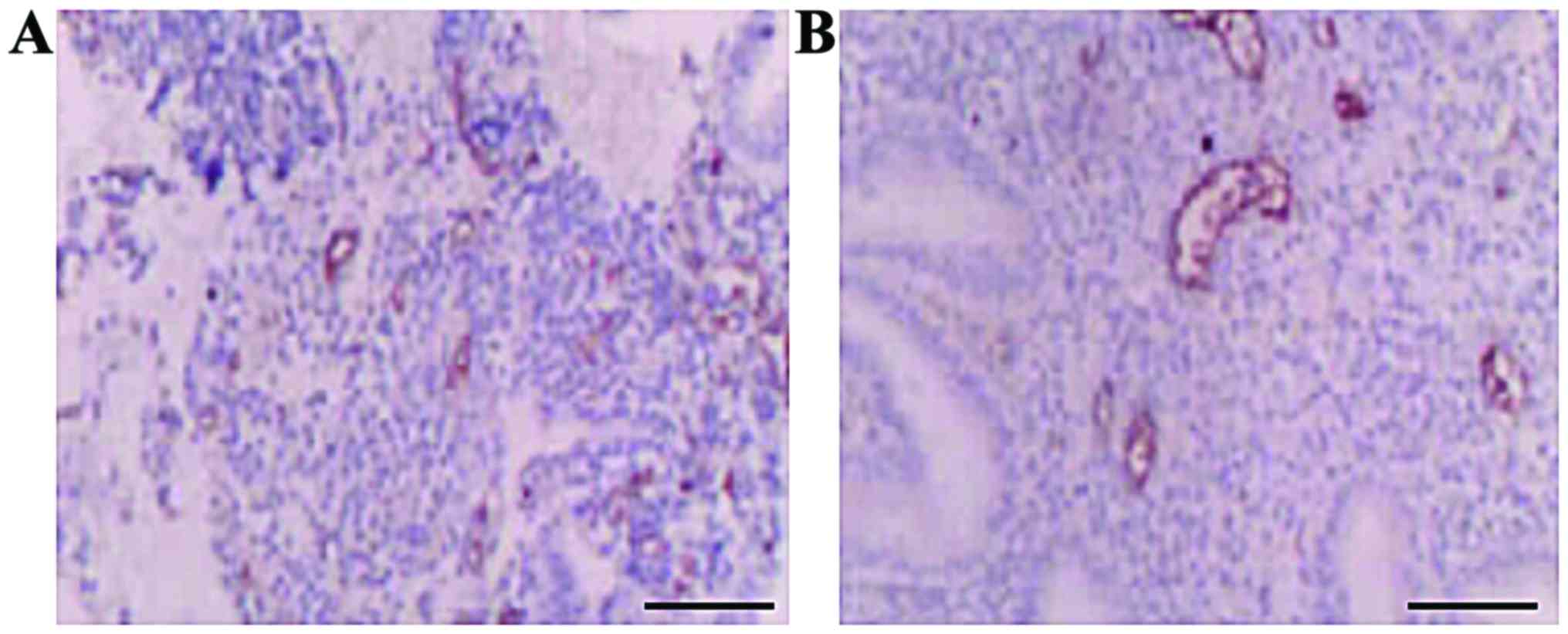|
1
|
Mangla M and Singla D: Transvaginal colour
doppler ultrasound in predicting response to chemoradiation in
patients with carcinoma of the cervix. S Afr J Gynaecol Oncol.
7:68–72. 2015.
|
|
2
|
El-Danasouri I, Sterzik K, Rinaldi L,
Pacchiarotti A, DeSanto M and Selman H: Effect of transferring a
morphologically impaired embryo with a good quality embryo on the
pregnancy and implantation rates. Eur Rev Med Pharmacol Sci.
20:394–398. 2016.PubMed/NCBI
|
|
3
|
Kim A, Han JE, Yoon TK, Lyu SW, Seok HH
and Won HJ: Relationship between endometrial and subendometrial
blood flow measured by three-dimensional power Doppler ultrasound
and pregnancy after intrauterine insemination. Fertil Steril.
94:747–752. 2010. View Article : Google Scholar : PubMed/NCBI
|
|
4
|
Hutchison SK, Stepto NK, Harrison CL,
Moran LJ, Strauss BJ and Teede HJ: Effects of exercise on insulin
resistance and body composition in overweight and obese women with
and without polycystic ovary syndrome. J Clin Endocrinol Metab.
96:E48–E56. 2011. View Article : Google Scholar : PubMed/NCBI
|
|
5
|
Erbil Y, Ozluk Y, Giriş M, Salmaslioglu A,
Issever H, Barbaros U, Kapran Y, Ozarmağan S and Tezelman S: Effect
of lugol solution on thyroid gland blood flow and microvessel
density in the patients with Graves' disease. J Clin Endocrinol
Metab. 92:2182–2189. 2007. View Article : Google Scholar : PubMed/NCBI
|
|
6
|
Guo TH, Tong XH, Luo LH, Luan HB, Zhou GX
and Wan YY: Value of microsurgical varicocelectomy for severe
oligo-asthenospermia patients failed in fertilization assisted by
in vitro fertilization. Eur Rev Med Pharmacol Sci. 20:1669–1674.
2016.PubMed/NCBI
|
|
7
|
Legro RS, Brzyski RG, Diamond MP,
Coutifaris C, Schlaff WD, Casson P, Christman GM, Huang H, Yan Q,
Alvero R, et al: NICHD Reproductive Medicine Network: Letrozole
versus clomiphene for infertility in the polycystic ovary syndrome.
N Engl J Med. 371:119–129. 2014. View Article : Google Scholar : PubMed/NCBI
|
|
8
|
Yang TF, Wang JD, Luo HJ, Wang XY and Li
FH: Relationship between ultrasonographic velocimetric parameters
and microvessel density in patients with papillary thyroid
carcinoma and its clinical significance. Zhonghua Er Bi Yan Hou Tou
Jing Wai Ke Za Zhi. 42:126–129. 2007.(In Chinese). PubMed/NCBI
|
|
9
|
Dogan O, Yildiz A, Temizkan O and
Pulatoglu C: Comparison of uterine, endometrial and ovarian blood
flow by transvaginal color Doppler ultrasound in ovulatory and
anovulatory cycles. Ginekol Pol. 87:581–584. 2016. View Article : Google Scholar : PubMed/NCBI
|
|
10
|
Vizza L, Smith CA, Swaraj S, Agho K and
Cheema BS: The feasibility of progressive resistance training in
women with polycystic ovary syndrome: A pilot randomized controlled
trial. BMC Sports Sci Med Rehabil. 8:142016. View Article : Google Scholar : PubMed/NCBI
|
|
11
|
Weidner N, Folkman J, Pozza F, Bevilacqua
P, Allred EN, Moore DH, Meli S and Gasparini G: Tumor angiogenesis:
A new significant and independent prognostic indicator in
early-stage breast carcinoma. J Natl Cancer Inst. 84:1875–1887.
1992. View Article : Google Scholar : PubMed/NCBI
|
|
12
|
Gu J, Han CH, Hu FF, Wang YB and Cao YJ:
The correlation analysis of human embryonic MMP-9 secretion and
embryo quality. Eur Rev Med Pharmacol Sci. 19:2354–2358.
2015.PubMed/NCBI
|
|
13
|
Salzillo PL, Salzillo ME, Iannella I,
Cobellis L and Colacurci N: Sonographic aspects in the study of
endometrial receptivity in women undergoing in vitro fertilization.
Minerva Ginecol. 62:267–275. 2010.(In Italian). PubMed/NCBI
|
|
14
|
Achache H, Tsafrir A, Prus D, Reich R and
Revel A: Defective endometrial prostaglandin synthesis identified
in patients with repeated implantation failure undergoing in vitro
fertilization. Fertil Steril. 94:1271–1278. 2010. View Article : Google Scholar : PubMed/NCBI
|
|
15
|
Harapan H and Yeni CM: The role of
microRNAs on angiogenesis and vascular pressure in preeclampsia:
The evidence from systematic review. Egypt J Med Hum Genet.
16:313–325. 2015. View Article : Google Scholar
|
|
16
|
Uysal S, Ozbay EP, Ekinci T, Aksüt H,
Karasu S, Işık AZ and Soylu F: Endometrial spiral artery Doppler
parameters in unexplained infertility patients: Is endometrial
perfusion an important factor in the etiopathogenesis? J Turk Ger
Gynecol Assoc. 13:169–171. 2012. View Article : Google Scholar : PubMed/NCBI
|
|
17
|
Gibson DA, Greaves E, Critchley HO and
Saunders PT: Estrogen-dependent regulation of human uterine natural
killer cells promotes vascular remodelling via secretion of CCL2.
Hum Reprod. 30:1290–1301. 2015. View Article : Google Scholar : PubMed/NCBI
|
|
18
|
Coughlan C, Ledger W, Wang Q, Liu F,
Demirol A, Gurgan T, Cutting R, Ong K, Sallam H and Li TC:
Recurrent implantation failure: Definition and management. Reprod
Biomed Online. 28:14–38. 2014. View Article : Google Scholar : PubMed/NCBI
|
|
19
|
Fatemi HM and Popovic-Todorovic B:
Implantation in assisted reproduction: A look at endometrial
receptivity. Reprod Biomed Online. 27:530–538. 2013. View Article : Google Scholar : PubMed/NCBI
|
|
20
|
Dechaud H, Bessueille E, Bousquet PJ,
Reyftmann L, Hamamah S and Hedon B: Optimal timing of
ultrasonographic and Doppler evaluation of uterine receptivity to
implantation. Reprod Biomed Online. 16:368–375. 2008. View Article : Google Scholar : PubMed/NCBI
|
|
21
|
Anicic R, Djukic M, Rakic S, Vasiljevic M,
Dimitrijevic D and Milicevic S: Evaluation of utero-ovarian
hemodynamics in relation to fertility and stage of endometriosis.
Clin Exp Obstet Gynecol. 39:526–528. 2012.PubMed/NCBI
|
|
22
|
Ceyhan L, Savas Cagri M, Baspinar S, Duman
L and Büyükyavuz BI: The correlation between preputial blood flow
and microvessel density in distal hypospadias: A prospective
clinical study. J Pediatr Urol. 10:103–106. 2014. View Article : Google Scholar : PubMed/NCBI
|















